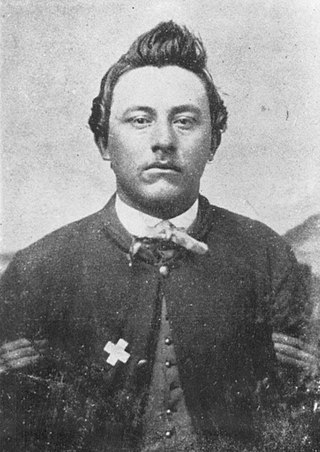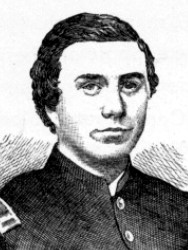
Thomas Ward Custer was a United States Army officer and two-time recipient of the Medal of Honor for bravery during the American Civil War. A younger brother of George Armstrong Custer, he served as his aide at the Battle of Little Bighorn against the Lakota and Cheyenne in the Montana Territory. The two of them, along with their younger brother, Boston Custer, were killed in the overwhelming defeat of United States forces.
The 12th West Virginia Infantry Regiment was an infantry regiment that served in the Union Army during the American Civil War. The regiment was particularly distinguished for its successful attack on Fort Gregg during the 1864 to 1865 Siege of Petersburg, receiving a golden eagle for its flagstaff as a token of appreciation from corps commander John Gibbon.

The 1st West Virginia Cavalry Regiment served in the Union Army during the American Civil War. Although it started slowly, it became one of the most active and effective of the West Virginia Civil War regiments—and had 14 Medal of Honor recipients, the most for any West Virginia regiment during the war. It was originally called the 1st Virginia Cavalry, not to be confused with the Confederate 1st Virginia Cavalry. Some reports added "Union," "Loyal" or "West" when identifying this regiment. After the Unionist state of West Virginia was officially admitted to the Union in 1863, the regiment became the 1st West Virginia Cavalry Regiment. The National Park Service identifies it as the 1st Regiment, West Virginia Cavalry.

Frederick A. Lyon was a soldier in the Union Army and a Medal of Honor recipient for his actions in the American Civil War.
The 47th Ohio Infantry Regiment was an infantry regiment in the Union Army during the American Civil War. The regiment had 14 Medal of Honor recipients, the most of any Ohio regiment during the war.

James Sweeney was a Union Army soldier during the American Civil War. He received the Medal of Honor for gallantry during the Battle of Cedar Creek fought near Middletown, Virginia on October 19, 1864. The battle was the decisive engagement of Major General Philip Sheridan's Valley Campaigns of 1864 and was the largest battle fought in the Shenandoah Valley.

Daniel P. Reigle was a Union Army soldier during the American Civil War. He received the Medal of Honor for gallantry during the Battle of Cedar Creek fought near Middletown, Virginia on October 19, 1864. The battle was the decisive engagement of Major General Philip Sheridan’s Valley Campaigns of 1864 and was the largest battle fought in the Shenandoah Valley.

Thomas McCoy Wells was an Irish born Union Army soldier and officer during the American Civil War. He received the Medal of Honor for gallantry during the Battle of Cedar Creek fought near Middletown, Virginia on October 19, 1864. The battle was the decisive engagement of Major General Philip Sheridan's Valley Campaigns of 1864 and was the largest battle fought in the Shenandoah Valley.
Thomas A. Anderson was a United States soldier and native of Pennsylvania who fought with the Union Army as a corporal in Company I of the 1st West Virginia Cavalry during the American Civil War. He was awarded his nation's highest award for valor, the U.S. Medal of Honor, for capturing the flag of a Confederate regiment during the Battle of Appomattox Station on April 8, 1865. The award was conferred on May 3 of that same year.
Captain Hugh P. Boon was an American soldier who fought in the American Civil War. Boon received the country's highest award for bravery during combat, the Medal of Honor, for his action during the Battle of Sailor's Creek in Virginia on 6 April 1865. He was honored with the award on 3 May 1865.

Francis Marion Cunningham was a United States' soldier and native of Pennsylvania who fought with Company H of the 1st West Virginia Cavalry during the American Civil War. Cunningham received his nation's highest award for bravery during combat, the U.S. Medal of Honor, for his action during the Battle of Sailor's Creek in Virginia on April 6, 1865. That award was conferred on May 3, 1865.

James Henry Gribben was an American soldier who fought in the American Civil War. Gribben received his country's highest award for bravery during combat, the Medal of Honor. Gribben's medal was won for capturing the flag of the Confederate 12th Virginia Infantry at the Battle of Sayler's Creek in Virginia on April 6, 1865. He was honored with the award on May 3, 1865.

Joseph A. Kimball was an American soldier who fought in the American Civil War. Kimball received his country's highest award for bravery during combat, the Medal of Honor. Kimball's medal was won for his capturing the flag of the Confederate 6th North Carolina Infantry at the Battle of Sailor's Creek in Virginia on April 6, 1865. He was honored with the award on May 3, 1865.

Thomas R. Kerr was a soldier in the Union Army in the American Civil War. Kerr received his country's highest award for bravery during combat, the Medal of Honor. Kerr's medal was won for his capturing the flag of the Confederate 8th Virginia Cavalry Regiment at Moorefield in West Virginia on August 7, 1864. He was honored with the award on June 13, 1894.
John Keough was a Union Army officer in the American Civil War who received the U.S. military's highest decoration, the Medal of Honor.
John P. Hughey was a Union Army soldier in the American Civil War who received the U.S. military's highest decoration, the Medal of Honor.

Rudolph Romeo Riddell was a Lieutenant in the United States Army who was awarded the Medal of Honor for gallantry during the American Civil War. On 6 April 1865, Riddell captured the flag of the 6th Alabama Cavalry of the Confederate Army. For this action, he was awarded the Medal of Honor on 10 May 1865.
Daniel A. Woods was an American soldier and recipient of the Medal of Honor.
Edwin F. Savacool was a captain in the United States Army who was awarded the Presidential Medal of Honor for gallantry during the American Civil War. He was awarded the medal on April 24, 1865, for actions performed at the Battle of Sailor's Creek in Virginia on April 6, 1865.








